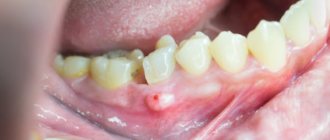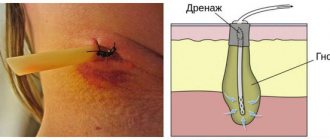Most often, a sore throat is associated with viral inflammation, which is accompanied by fever, cough, runny nose and minor difficulty swallowing. But, unfortunately, in some situations these diseases can be complicated by the development of purulent-inflammatory complications, for example, peritonsillar abscess, and the task of the ENT doctor at the present stage is the correct diagnosis of this complication and timely treatment, because this complication does not tolerate deposits and is fraught with more significant spread of infection into the deep tissues of the neck. At the GMS Hospital Otolaryngology Center, a comprehensive approach is used to treat peritonsillar abscesses, combining conservative and surgical techniques.
More about the disease
Peritonsillitis is an acute condition secondary to tonsillitis or tonsillopharyngitis, which results in the penetration of an infectious agent (bacteria) into the loose peritonsillar tissue (peritonsillar space). The process is always one-sided, as a result of which it has certain symptoms:
- pain or increased pain on one side;
- severe difficulty swallowing;
- swelling and bulging on the neck on one side;
- asymmetry and bulging of pharynx tissues.
A peritonsillar abscess occurs when a cavity filled with pus forms, located in the peritonsillar (peritonsillar) tissues.
It can form several days after the development of a sore throat or an exacerbation of tonsillitis. Less commonly, due to traumatic injury to the oropharynx or penetration of a foreign body into the tissue around the tonsils. In people with a weak immune system, an abscess can form within a day. It is more often unilateral, but cases with bilateral paratonsillar abscess have been reported in the literature. This pathology is one of the most severe purulent lesions of the oropharynx. With further spread, the infection moves into the deep tissues of the neck (parapharyngeal space), which can lead to a life-threatening condition. Depending on their location, there are several forms of peritonsillar abscess, but all of them require surgical treatment.
The Surgical Otolaryngology Center at GMS Hospital provides proper treatment and diagnosis of paratonsilitis and paratonsillar abscess of any form. Treatment tactics are selected by specialists individually, depending on the stage of the disease, the presence of complications and concomitant pathologies.
Opening an abscess (furuncle) of the ear
Ear boil is a purulent-inflammatory disease of the hair follicle of the skin of the auricle and external auditory canal.
The cause of an ear boil is microtrauma when scratching or cleaning the ear with a cotton swab or foreign objects (matches, pins, etc.). Pathogenic microflora settles on the injured surface of the skin of the external auditory canal and an inflammatory process develops. This is facilitated by water getting into the ear, metabolic disorders that change the barrier function of the skin (diabetes, obesity), decreased immunity, unfavorable ecology and environmental factors (air pollution, working in a dusty room, etc.).
The development of the disease goes through several stages:
- infiltrative,
- abscess formation and necrosis,
- recovery
The disease is characterized by diffuse pain in the affected ear, aggravated by chewing, talking, and opening the mouth. Due to swelling of the skin of the external auditory canal, its lumen narrows until there is no lumen at all. This leads to a feeling of ear fullness and decreased hearing on the affected side, since sound waves cannot be carried to the eardrum and transmitted along the chain of auditory ossicles to the inner ear. Upon examination, the skin of the external auditory canal is hyperemic and swollen; at the stage of abscess formation, an area of necrosis with a purulent core can be seen. As a rule, regional lymph nodes are involved in the process, enlarging and causing pain upon palpation. Depending on the stage of the disease and the extent of damage to the skin of the external auditory canal, the clinical picture may be limited only to local manifestations, or accompanied by symptoms of general intoxication - high fever, weakness, malaise, headache.
Diagnosis of an ear boil
Diagnosis of an ear boil is not difficult; it is enough to collect an anamnesis, the patient’s characteristic complaints and examine the external auditory canal using an otoscope or endoscope.
Treatment of ear boil
Treatment for ear boils depends on the stage of the disease. At the infiltration stage, local alcohol applications (calendula solution, chamomile, iodine tincture), oral antibiotics, antiplatelet agents (aspirin) to prevent thrombosis, and antihistamines are prescribed. If it was possible to start treatment in the first hours or day of the disease, then the process is localized and quickly resolves without a stage of suppuration. It should be remembered that self-medication and independent attempts to open an abscess threaten the development of serious complications, including death.
Opening a boil in the ear
In the stage of suppuration and necrosis, it is recommended to open the boil and drain its cavity, rinse with antiseptic solutions, continuing active general therapy.
In the resolution stage, a good therapeutic effect is achieved by the use of physiotherapeutic procedures, such as ultraviolet irradiation of the affected area, laser therapy or photochromotherapy.
Doctors at the ENT Clinic in Chertanovo carry out the full range of necessary treatment measures for patients with ear boils, selecting an individual treatment regimen and choosing certain techniques based on the stage of the disease, the patient’s age, duration of the disease and concomitant pathology. After opening the boil, it is possible to conduct detoxification therapy and monitor the patient in a day hospital. During the recovery stage, patients undergo laser treatment or photochromotherapy of the external auditory canal in order to improve the regeneration process of the skin of the external auditory canal and prevent relapses in the future.
After recovery, it is necessary to conduct an examination for concomitant conjugate, hidden pathology to prevent the occurrence of boils in the future, since in the absence of treatment of the underlying disease, frequent relapses of the disease are possible.
Why is it necessary to open and drain a peritonsillar abscess?
Peritonsillar abscess is an urgent condition in otolaryngology. The proximity of vital structures (windpipe, large vessels of the head and neck) requires immediate diagnosis and treatment. In the initial stages, when an abscess has not yet formed, the pathology responds well to drug therapy. A course of antibiotic therapy, anti-inflammatory and painkillers is prescribed. If conservative treatment is ineffective, the abscess is opened surgically.
Peritonsillar abscess is dangerous due to its complications, fraught with the development of phlegmon, mediastinitis and even sepsis. The Otolaryngology Department at the GMS Clinic has everything you need to accurately diagnose and treat peritonsillar abscesses.
The opening of the abscess is carried out using modern surgical equipment. During the operation, the potential of laser and radio wave surgery is actively used, which allows the procedure to be performed in the most gentle manner, eliminating the development of surgical complications. Opening abscesses in children is performed under anesthesia, which significantly increases the comfort of the intervention.
Causes of throat abscess
In children, the most common cause of abscess development is an infection caused by streptococcus, staphylococcus, and, less commonly, E. coli. The disease is almost always secondary to the pathology that provoked it. The infection enters the throat through the lymphatic tract, so nearby lymph nodes are always affected and inflamed.
Primary foci of infection in childhood:
- Purulent otitis;
- Mastoiditis;
- Parotitis occurring with complications;
- Rhinitis;
- Pharyngitis;
- Complications of acute infectious diseases (influenza, ARVI, measles, scarlet fever, diphtheria);
- Complications after surgery (adenotomy, tonsillectomy).
The rapid development of the inflammatory process is facilitated by reduced immunity, rickets and a history of diathesis in the child.
In adults, the formation of a pharyngeal abscess most often occurs due to tissue trauma.
Causes of throat abscess in adults:
- Damage to the throat from rough food, bone, or foreign object;
- Trauma to the mucous membrane of the throat after gastroscopy, bronchoscopy, endotracheal anesthesia;
- Complication after tonsillitis;
- Consequence of tuberculosis, syphilis;
- Presence of caries.
The rapid spread of infection is facilitated by a history of HIV infection, diabetes mellitus, malignant tumor, somatic diseases, or any process that reduces immunity in an adult. The causes of purulent inflammation in the throat cannot be strictly limited to age categories. Predisposing factors from each group can occur at any age.
Cost of treating peritonsillar abscess
The prices indicated in the price list may differ from the actual prices. Please check the current cost by calling +7 495 104 8605 (24 hours a day) or at the GMS Hospital clinic at the address: Moscow, st. Kalanchevskaya, 45.
| Name | Price |
| Opening of the epiglottis abscess | RUB 54,999 |
| Opening abscesses, phlegmon of the laryngopharynx | RUB 64,995 |
| Opening a paratonsillar or retropharyngeal abscess | RUB 46,998 |
| Drainage of peritonsillar abscess | RUB 24,997 |
| Tonsillectomy + removal of peritonsillar abscess (According to Quinzey) | RUB 189,994 |
Dear Clients! Each case is individual and the final cost of your treatment can only be found out after an in-person visit to a GMS Hospital doctor. Prices for the most popular services are indicated with a 30% discount, which is valid when paying in cash or by credit card. You can be served under a VHI policy, pay separately for each visit, sign an agreement for an annual medical program, or make a deposit and receive services at a discount. On weekends and holidays, the clinic reserves the right to charge additional payments according to the current price list. Services are provided on the basis of a concluded contract.
Plastic cards MasterCard, VISA, Maestro, MIR are accepted for payment. Contactless payment with Apple Pay, Google Pay and Android Pay cards is also available.
Western standards of treatment (evidence-based medicine)
Continuous staff development
Regular interaction with leading Russian and foreign medical institutions
Modern medical equipment and advanced diagnostic and treatment methods
Unified standard of service
We work around the clock 24/7/365
Make an appointment We will be happy to answer any questions Coordinator Oksana
Signs and symptoms of paratonsillitis
The disease has an abrupt onset. An abscess forms a few days after an exacerbation of tonsillitis or the onset of a sore throat and is accompanied by vivid symptoms:
- acute pain in the throat, radiating to the jaw or ear;
- sensation of a “lump” in the throat;
- fever (temperature 39-40°C);
- submandibular lymph nodes are greatly enlarged;
- difficulty swallowing (even drinks);
- the appearance of a repulsive odor from the mouth;
- neck pain that gets worse with exercise;
- general weakness;
- inability to fully open the mouth;
- headache;
- speech impairment (voice as if there is a hot potato in the mouth);
- difficulty breathing (with large ulcers).
Spontaneous breakthrough of suppuration into the throat cavity is accompanied by an improvement in well-being and the appearance of an admixture of pus in the saliva.
The spread of the abscess contents into the peripharyngeal space significantly worsens the condition, so there is no need to delay operations to open the abscess. If you have even one of the symptoms listed above, schedule a consultation with an otolaryngologist today. Doctors at the Center for Operative Otolaryngology at GMS Hospital use gentle microsurgical techniques, which contributes to a speedy recovery and the absence of relapses of the disease.
Opening a hematoma (abscess) of the nasal septum
Traumatic injuries to the nose are often accompanied by external bleeding of varying degrees of intensity, which stops on its own or with the help of nasal tamponade. With normal blood clotting and the absence of severe concomitant pathology, bleeding is not dangerous and the body very quickly compensates for this blood loss.
It is very important to monitor a patient with a nasal injury in the first days after the injury, since complications in the form of a hematoma of the nasal septum and its subsequent abscessation are possible. According to statistics, in 1 out of 100 cases of nasal injuries we encounter such complications. Considering the abundant blood network in the nasal cavity and the direct connection with the vessels of the brain, the high importance and timeliness of the primary diagnosis of these nasal diseases for the prevention of serious intracranial complications becomes obvious.
Causes of hematoma of the nasal septum
The immediate cause of a hematoma of the nasal septum is a trauma to the nose, which results in damage to the vessels of the perichondrium in the cartilaginous part of the nasal septum and hemorrhage into the cavity between the mucous membrane of the nasal cavity and the cartilage. Predisposing factors are disorders of the blood coagulation system, acute respiratory diseases, in which a hematoma of the nasal septum can appear even with the slightest trauma to the nose.
Symptoms of nasal septum hematoma
The main and first symptom of the development of a hematoma of the nasal septum is difficulty in nasal breathing, which develops several days after the injury to the nose, on one or both sides, increasing in intensity every day. The addition of a headache, increased body temperature, and malaise indicate the addition of pathogenic microflora and the formation of an abscess of the nasal septum.
Diagnosis of nasal septum hematoma
Due to the high risk of developing intracranial complications, diagnosis of nasal septum hematoma and its possible abscess formation should be timely and based on characteristic complaints, medical history and rhinoscopy data.
Treatment of nasal septum hematoma
Treatment of hematoma of the nasal septum consists of emptying the hematoma cavity, leaving drainage and tamponade of the nasal cavity on both sides for 1-2 days. General treatment consists of prescribing antibiotics and hemostatic agents for changes in hemostasis. In case of an abscess of the nasal septum, the abscess is opened and emptied, drainage is introduced into the abscess cavity and systemic antibiotic therapy is performed.
As a rule, with timely diagnosis and adequate treatment, recovery occurs within 5-7 days.
The ENT Clinic in Chertanovo provides comprehensive care to patients after nasal injuries complicated by the development of a hematoma of the nasal septum and its abscess formation.
Diagnostics
For the differential diagnosis of paratonsillitis, the following research methods are used:
- examination by an otolaryngologist;
- laryngoscopy;
- pharyngoscopy;
- laboratory tests (blood tests, culture for flora and sensitivity to antibiotics, etc.).
In some cases, to clarify the diagnosis, additional studies are performed - ultrasound, CT scan of the soft tissues of the head and neck.
A comprehensive examination allows you to assess the condition of the abscess and tonsil, determine treatment tactics and the scope of intervention. You can complete all the required tests at the GMS clinic in a day.
Preparing for surgery
Surgery is performed only when the abscess is “ripe,” that is, a purulent pocket is completely formed. This usually occurs on the 5th day after tonsil swelling occurs.
Checking the readiness of the cavity for opening is carried out by a diagnostic puncture. Using a large needle, a puncture is made in the place that sticks out the most. All manipulations are controlled by an ultrasound machine or endoscopic observation. If pus is detected in the sample, it means that the abscess is ripe for surgery.
If necessary, a blood test is prescribed, as well as a culture to determine the pathogen and check for resistance to antibacterial drugs.
After the examination, the patient is sent to the operating room, where the abscess will be surgically opened.
Treatment methods
The treatment tactics for paratonsillitis depend on the extent of the spread of the purulent process and the presence of complications. Peritonsillitis in the initial stage is treated conservatively, with antibiotics, decongestants, painkillers and anti-inflammatory drugs. If drug treatment is ineffective or an abscess forms, the abscess is surgically opened and its cavity is drained. The opening of the paratonsillar abscess is carried out under local anesthesia. The otolaryngologist dissects the wall of the abscess, removes the purulent contents, and rinses the cavity with an antiseptic. An improvement in the condition is observed immediately after opening and draining the abscess.
You have questions? We will be happy to answer any questions Coordinator Tatyana
Indications for autopsy
Drug therapy is possible only at the stage of paratonsillitis, when there is inflammation, but there is no abscess yet. If antibiotic therapy was not carried out in the first two to three days, the abscess will need to be opened. At the stage of purulent inflammation, conservative treatment will not give a positive result.
In 25% of cases, the abscess opens on its own without surgical intervention. At the same time, the temperature drops sharply, the pain goes away and recovery occurs. But if this does not happen, then the patient is shown opening the abscess cavity with a scalpel.
If the operation is not performed, then the purulent inflammation can go further, which poses a danger to life.
Prevention of paratonsillitis
The following simple preventive measures will help prevent the development of peritonsillar abscess:
- strengthening the immune system;
- healthy lifestyle;
- timely treatment of acute and chronic diseases of the ENT organs (sinusitis, adenoids, pharyngitis, tonsillitis, etc.), caries;
- rejection of bad habits.
In the presence of recurrent abscesses, elective tonsillectomy is recommended.
Opening a peritonsillar abscess at the GMS clinic is a simple and safe surgical procedure that is performed in an outpatient or inpatient setting. Recovery takes 10-14 days, after which you will return to your normal life. You can make an appointment with an otolaryngologist at GMS Hospital by phone or using an online application.
Types and forms of PTA
Depending on the location of inflammation, there are:
- anterior paratonsillar abscess. In most clinical cases, pus accumulates near the upper pole of the tonsil, behind the anterior arch and soft palate;
- lateral paratonsillar abscess. Exudate forms between the pharyngeal fascia and the tonsil capsule. There are right-sided and left-sided PTA;
- posterior abscess. Pus accumulates in the posterior arch area. Pathology can provoke swelling of the larynx with subsequent stenosis;
- lower PTA. Rarely seen. In this case, the anterior palatal arch is displaced downwards from the front due to infiltration of the lower part.
Peritonsillar abscess has the following clinical and morphological forms:
- edematous. It occurs without significant inflammation without significant manifestations of symptoms. Because of this, the form of the disease is rarely diagnosed;
- infiltration Hyperemia occurs. Manifested by pain, fever;
- abscessing. Forms 4-7 days after the development of infiltration changes.










